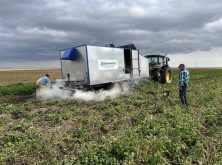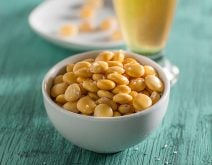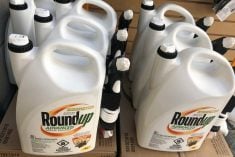Integrated weed management (IWM) is not rotating herbicides or modes of action. IWM is combining one of more different weed management techniques, such as chemical, cultural, physical or biological weed control.
Some IWM methods are easy to implement, such as making sure you select good, certified seed that will grow vigorously and out-compete weeds. Seeding at a higher rate than normal is another surefire way of suppressing weeds. Having a better crop rotation doesn’t encourage the same weeds to grow every year and proliferate.
“Those are some of the real basics, but when you combine them, and you do enough of those little things, you won’t have to use herbicides so often,” says Neil Harker, weed ecology and crop management research scientist with AAFC’s Research and Development Centre at Lacombe, Alberta.
Read Also

Cancer agency reclassifies another herbicide ‘probably carcinogenic’
The WHO’s cancer research agency has now put atrazine, a herbicide well known to corn growers, in the same potential-hazard category where the agency put glyphosate.
Weed resistance driving IWM
Increasing weed resistance problems across Canada and other areas of the world are driving more and more farmers to look at IWM. “If we can find ways to use herbicides less often, we put less selection pressure on weeds for resistance,” says Harker. “Integrated weed management is being driven right now by producers’ desire to avoid, or restrict weed resistance.”
Early seeding, if possible, is another useful tool to try and get a jump on some weeds. “Early seeding will give you a relative time of emergence advantage and that’s huge on weeds,” says Harker. “For weeds that don’t come up that early, if the crop can get a couple of weeks ahead of them, the herbicides will work much better because they don’t need to be as active. And the crop has much less yield loss, so there’s less need for herbicide.”
But seeding the same crops early every year isn’t necessarily beneficial, adds Harker. “If we did all early seeding on all our crops year after year on our fields, we would select for weeds that emerged earlier than the crop or we’d select for weeds that came up much later and could still proliferate,” he says.
Aim for diverse rotations
It’s better to have a crop rotation that encourages different seeding dates, such as fall seeding winter cereals such as winter wheat, winter triticale or fall rye. “When you do that, you don’t even need a wild oat herbicide because the crop is so far ahead of the wild oat in the spring,” says Harker.
Winter cereals, particularly fall rye, are competitive with wild oats because they emerge long before wild oats, but winter cereals should not be grown continuously or winter annual weeds like downy brome can become a problem. The key message is that a diverse crop rotation is more effective to control weeds than a less diverse rotation of annual crops.
One of the biggest impediments to IWM is crop prices. “Everybody wants to grow the most profitable crop each year so they’ll stick with more simple rotations. It’s no surprise that because we grow summer-annual crops year-after-year that our biggest weed problems for the last 40 years are summer-annual weeds such as wild oats, wild buckwheat, and green foxtail,” says Harker.
If farmers include a perennial forage such as alfalfa in the rotation, it can dramatically reduce weed pressure. “Perennial forages allow us all kinds of different methods for suppressing weeds and reducing weed seed production,” says Harker.
Field surveys (just before spraying) from Manitoba and Saskatchewan found the average weed density in cereal crops following cereal crops was 106 plants/m2. The average weed density in cereal crops following alfalfa was only 48 plants/m2. As well, problem weeds such as wild oats, Canada thistle, wild mustard and cleavers were significantly lower in cereal fields preceded by alfalfa. However, populations of weeds such as stinkweed and dandelion can increase by having alfalfa in rotation. Research has shown that an optimum rotation should include three years of alfalfa followed by three years of annual cropping. The benefits of weed suppression and added nitrogen from this rotation begin to decline after the alfalfa stand is three-years-old. Alfalfa is best removed in fall with a herbicide application as tillage can dry out soils and affect yields of the following annual crop and stimulate annual weeds to germinate.
Fertilizer management is another crucial factor in IWM. Broadcasting fertilizer feeds weeds as much as the crop, and too much fertilizer in the seed row can damage the crop’s ability to compete. “That can happen if you are seeding too fast or have worn openers or are just being careless,” says Harker. “Fertilizer is really important, because when you feed the crop properly, and place it correctly, you can give it an advantage over weeds.”
Limiting the spread of weeds
Research is underway all over the world into physical weed control methods, especially in Australia where they are looking at harvest weed seed control by collecting or baling chaff, or crushing weed seeds with the Harrington Seed Destructor.
An inexpensive and simple weed control method is limiting their spread from field to field and there are many things producers can do to accomplish this. They can ensure that equipment such as combines are clean before moving to the next field, use a chaff wagon to collect weed seeds, and tarp grain loads to prevent weed seeds from blowing out during transport. Producers can control weeds such as Canada thistle and scentless chamomile in ditches, field edges and around sloughs, and compost manure for at least a year before using on fields to reduce the viability of many weed seeds. Monitoring fields carefully may allow for spot spraying of new weeds before they become too established.
A new project at AAFC in Lacombe is using a CombCut to cut weeds before they can set seed. “I believe that producers should remain open minded to some of these new ideas,” says Harker. “Before they weren’t interested because they were happy with herbicides, but they’re less happy now.”
IWM strategies that work
These strategies are listed with thanks to Alberta Agriculture and Forestry:
1. Early seeding:
Seeding as early as possible has a number of advantages. It can help prevent weeds from getting a head start on the crop. Research shows that yield loss in barley can vary from 17 per cent when wild oats emerge five days before the crop to only three per cent when wild oats emerge five days after the crop. Early seeded crops can take advantage of spring moisture and longer growing days to provide a yield advantage. Early seeding canola results in less flower blasting because the crop flowers before the hottest part of the summer. Delaying seeding to control initial flushes of weeds can result in yield loss that exceeds the cost of applying an in-crop herbicide.
2. Seed shallow:
Seed as shallow as possible for quicker emergence. Seeding deep, especially into cool soils can delay emergence, and make seedlings more susceptible to disease and herbicide damage. Under good moisture conditions, seed canola and cereals no deeper than half an inch and one inch, respectively. In dry soils, seed canola and cereals at one and two inches, respectively.
3. Pack the seed row:
Pack the seed row well after drilling in the seed to retain more soil moisture for crop germination. Soil between the seeded rows remains looser and drier, and is not ideal for weeds to germinate.
4. Watch row spacing:
Wider row spacing, beyond 12 inches, can reduce crop emergence and competitiveness with weeds due to inter-plant competition.
5. Seed at higher rates:
Generally a higher seeding rate will help crops outcompete weeds and increase yield. Studies have shown that increasing the recommended seeding rate by 50 per cent reduced weed biomass in three of four years in wheat, canola and barley and in two of four years in peas. Yields also increased in two of four years in canola, barley and peas and in one year in wheat.
6. Maintain fertility:
When increasing seeding rates, fertility must be maintained to produce higher yields. In studies, increasing the seeding rate of barley only gave higher yields when fertility was adequate, and actually resulted in decreased yields when fertility was too low.
7. Choose good seed:
Plant vigorous seed to help produce a competitive crop, particularly when conditions for germination and seedling growth are less than ideal such as in cold, dry soils or when there is disease or insect pressure. Test seed for both germination and vigor prior to seeding to assess how quickly and uniformly the seed will germinate under stressful conditions.
8. Diversify crop rotations:
Production systems that create diversity in cropping patterns, tillage and herbicide use make it difficult for weeds to adapt. Rotating between annual grain crops such as field peas, canola and spring cereals provides an opportunity to rotate between herbicide groups, thereby slowing the development of weed resistance. Unfortunately herbicide resistance is increasingly becoming an issue for farmers as weeds adapt, particularly in less diverse, annual crop rotations. Diversifying rotations by including annual crops, perennial forages, winter cereals and silage crops creates variation in cropping patterns such as seeding and harvest dates, and makes it hard for weeds to adapt.
9. Use herbicides optimally:
IWM can create an opportunity to reduce herbicide use, but herbicides are still a powerful weed management tool and producers should generally use the recommended label rates. It may be possible to avoid a herbicide application if weeds do not reach economic thresholds. The economic weed threshold is the weed density at which the cost of control is equal to the value of the crop yield lost from weed competition.
For example, say a 60 bu./ac. barley crop is worth $2.50/bu, and the cost of applying a herbicide to control wild oats is $16/ac. Based on the crop and application prices, the farmer can afford to lose 6.4 bu./ac. (a 10.6 per cent yield loss) before the application of the herbicide would be cost effective.
For more detailed information about IWM practices visit Alberta Agriculture and Forestry’s website.
















